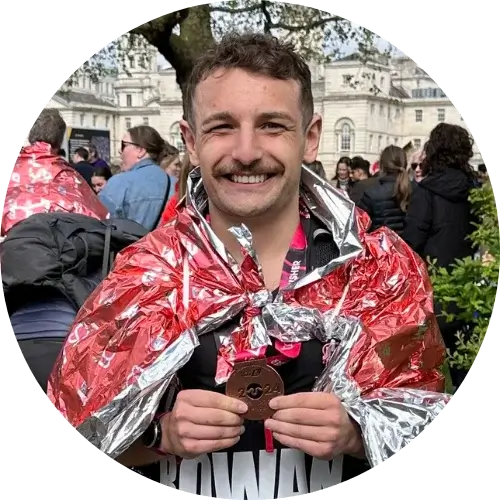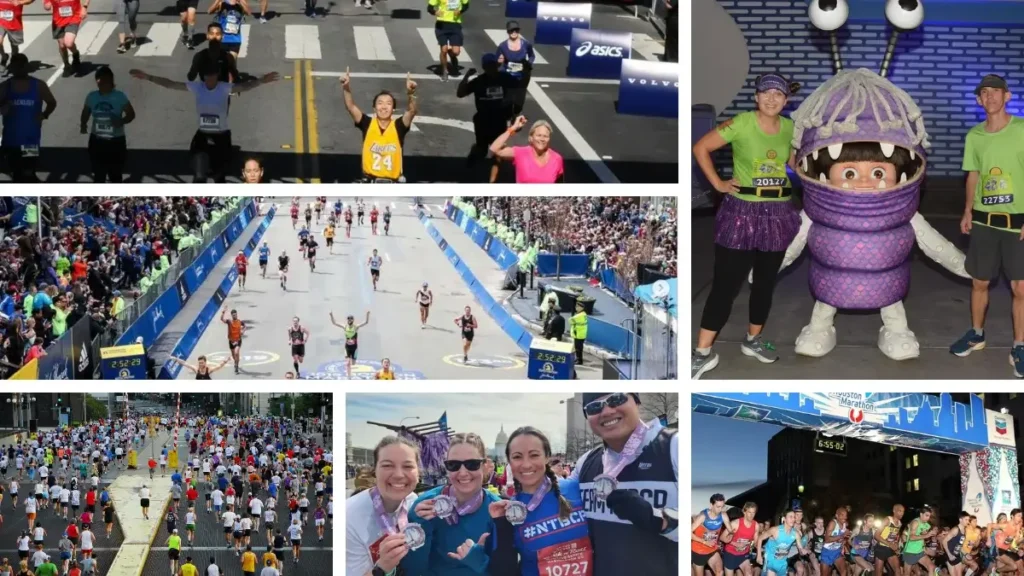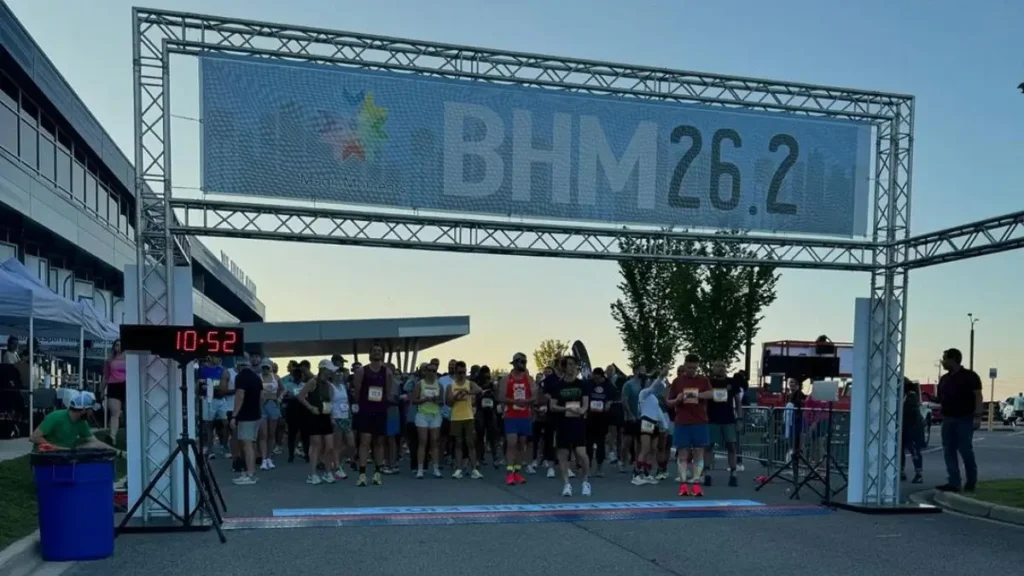From Staten Island to Buffalo to Bath to Sackets Harbor, and more.
Running a marathon in New York means different things depending on where you lace up. One weekend it’s skyscrapers and crowds, the next it’s quiet farm roads or a lakeside breeze. There’s the obvious one (the marathon everyone knows), but there are also small-town races where the water stations double as local block parties and the course is marked with handwritten signs.
Setting matters when you run a marathon. Hills hit different when there’s a wide lake view at the top. Roads feel less endless when the neighbors are out in lawn chairs ringing cowbells. If you’re the kind of runner who likes knowing where the good port-a-potties are or who appreciates a soft race shirt that somehow becomes your favorite long sleeve, this post is probably for you.
Looking for a different state?
What are the Best Marathons in New York?
New York City Marathon
Staten Island | Nov 2, 2025


Course Type: Rolling Hills
Elevation Gain: 810 feet (246m)
Participants: 55,521 Finishers
Price: $255 for New York Road Runners Members, $315 for U.S. runners who aren’t.
There’s no way around it: the TCS New York City Marathon is one of the biggest, loudest, and most complicated marathons out there. It’s the kind of race that feels just as much about the logistics as the running itself. From the early morning commute to the start village at Fort Wadsworth, to the long shuffle through Central Park after you’ve crossed the finish line, every part of the day feels like an experience.
But somehow, all of that chaos becomes part of what makes it memorable. The course is tough, with several bridge climbs that sneak up on your legs, especially the Queensboro Bridge, which is both physically and mentally brutal thanks to its steep incline and eerie silence. But then you hit First Avenue and the roar of the crowd practically lifts you off the pavement.
That kind of contrast happens over and over again during this race. You’ll go from isolated moments on bridges or long straights to full-on block parties in Brooklyn or Harlem. The crowd support is constant and intense. Some runners love the energy, others find it overwhelming. Either way, it’s hard to ignore. Everyone feels different about this race, which makes sense given how massive and layered this event is. Some people run it once, check it off their bucket list, and move on. Others come back year after year.
It’s not the easiest race to get into or navigate, and it’s certainly not the quietest. But if you want to see a city through the eyes of 50,000 other runners, on a day when the streets truly belong to the sport, this one stands apart from any other marathon in New York State.
Buffalo Marathon
Buffalo | May 24, 2026
Course Type: Mostly Flat
Elevation Gain: 589 feet (179m)
Participants: 1,209 Finishers
Price: $120
The Buffalo Marathon has built a loyal following for good reason. It’s a race that knows exactly what it is. Held every Memorial Day weekend, it’s one of the most established marathons in upstate New York, and the organizers clearly prioritize the runner experience. The course is certified and a Boston Qualifier, with mostly cool early-morning conditions, making it a great pick for anyone looking to PR. Runners start downtown and make their way through neighborhoods like Allentown and Delaware Park, past the Albright-Knox Art Gallery and SUNY Buffalo State, then head south along the Niagara River and back toward the finish at Niagara Square.
The race weekend itself is tightly run. The expo is hosted at the Buffalo Niagara Convention Center, just a short walk from most downtown hotels. You’ll find everything close by: packet pickup, the starting corrals, the finish line, even restaurants for post-race carbs. There’s no long shuttle ride or confusing point-to-point logistics. The start is early, with the full and half marathons both beginning at 6:30 a.m., which helps beat the late-May sun. On-course support is solid, with over 20 water stations, Gatorade Endurance, GU energy gels, and enthusiastic volunteers who’ve clearly done this before.
Crowd support comes in waves. You’ll get pockets of strong energy downtown and near the parks, then quieter, more residential stretches that make it easy to settle into a rhythm. It’s not a wall-to-wall-spectator kind of race, and that’s part of its charm. There’s a practical, no-drama feel to the whole weekend. It’s not trying to be a spectacle; it just delivers a fast, well-supported course, a smooth race-day experience, and a laid-back city that’s easy to navigate. If you’re tired of logistical headaches and just want to run, Buffalo makes that easy.
Wineglass Marathon
Bath | Oct 5, 2025


Course Type: Downhill
Elevation Gain: 411 feet (125m)
Participants: 1,816 Finishers
Price: $175
The Wineglass Marathon is a small but well-loved race held every October in New York’s Southern Tier. The course runs point-to-point from Bath to Corning, with gentle elevation loss over 26.2 miles. It’s known for being fast without feeling like it’s trying too hard, just a quiet, smooth course with very little climbing, some stretches of forest, and long straightaways through the Finger Lakes countryside. Most of the downhill comes in the early miles, with a few rolling sections in the middle. By the time you hit the homestretch into downtown Corning, there’s a crowd waiting near the glass museum and the finish line banner hanging across Market Street.
The vibe of the whole weekend is laid back. There are no huge expos or big-name elites. Instead, you get buses to the start, a warm-up walk from the shuttle drop-off, and a bunch of other runners chatting in throwaway layers while sipping coffee from travel mugs. It can be cold at the start (like wearing gloves and a hat cold), but it usually warms up enough by mile five that you can ditch the layers and settle in. The weather is usually ideal for racing: crisp air, maybe 45–50°F, and the fall leaves are often near their peak.
Aid stations are spaced every couple of miles and stocked with water, sports drinks, and volunteers who still seem to be having fun by mile 20. The crowd support is scattered but heartfelt, locals sitting in lawn chairs or ringing cowbells from their driveways. You get the sense that this race means something to the town. At the finish, they hand you a glass finisher medal made by a local artist. It’s the kind of race where people return year after year not because it’s flashy, but because it’s quietly good.
Sackets Harbor Marathon
Sackets Harbor | Sep 7, 2025
Course Type: Rolling Hills
Elevation Gain: 570 feet (173m)
Participants: 250 Finishers
Price: $109-$119
Sackets Harbor is the kind of place that makes you forget you’re at a race until the gun goes off. It’s small, scenic, and sits right along the edge of Lake Ontario, where the sky feels big and the air off the water wakes you up fast. The marathon course loops you through the village streets and then sends you out into open country roads, with a stretch along the lake at both ends. It’s an out-and-back course, gentle on elevation, with a slight uphill early that quietly becomes a gift on the way back.
The race itself still feels new, but in a good way. There’s an attention to detail that comes through, whether it’s the stacked water stations, the easy parking, or the way packet pickup doesn’t feel like a chore. There’s a bell at the finish line you can ring if you PR or qualify for Boston, and people actually do it. It’s not just there for show. There’s a 360° photo booth too, which is good fun and not something you see at a lot of races.
Locals come out for this one. The energy in Sackets is something you’ve got to experience.
The swag is simple but solid, you get a long-sleeve 1/4 zip shirt that’s a fan favorite, a sweet medal, and a koozie from a local sponsor. Nothing flashy, but it all fits. If you’re lucky with the weather, you get a crisp morning and plenty of sun later. If not, there’s still the lake, the crowd, and a good shot at a strong finish. It’s a race that doesn’t feel like it’s trying too hard. It doesn’t need to.
What’s It Like Running a Marathon in New York?
New York’s a big state, and running a marathon here feels very different depending on where you are. The big-city energy of the New York City Marathon is its own thing entirely — crowded, electric, loud in the best way. But head upstate and the vibe shifts fast. Places like Sackets Harbor and Buffalo trade high-rise skylines for water views, quiet streets, and routes where you can actually settle into a rhythm.
Upstate courses tend to be flatter, which is good news if you’re chasing a PR or eyeing a Boston Qualifier. The Buffalo Marathon, for example, is known for its low elevation gain and smooth pacing. Sackets Harbor has a slight climb out and a gentle return, which makes the second half feel rewarding if you’ve managed the early effort well.
The weather’s a bit of a wildcard depending on the time of year. May in Buffalo can mean cool and breezy or muggy and hot. September in Sackets Harbor usually brings sun and not much shade. One runner even noted how thirsty they were by the finish, despite plenty of water stations. The early start times help, but it’s worth training for variable conditions.
And then there’s the atmosphere, which shifts from event to event. Some races feel big even if they’re not, and others feel quiet in a way that’s almost meditative. At Sackets, it’s the little stuff — a volunteer cheering with a horse nearby, a local business sponsoring koozies, a finisher’s bell — that reminds you you’re running in someone’s actual hometown, not just a mapped-out loop.
Tips for a Smooth Marathon Weekend in New York
Even smaller races in New York can have logistical quirks, especially when you’re traveling from out of town. Here are a few runner-tested tips to make race weekend less stressful:
1. Stay Close to the Start (or Finish)
In places like Sackets Harbor, the start and finish line are in the same spot, which makes it easy. Some runners have stayed in nearby Airbnbs right on Lake Ontario, which adds to the whole experience. If you’re eyeing a village race, aim to book early – smaller towns mean fewer hotel rooms.
2. Pack for the Weather
Conditions can change fast, especially near the water. Early morning starts in Sackets or Buffalo can feel chilly, even in late spring or early fall. Bring layers, even if the forecast looks clear. A throwaway hoodie at the start line can go a long way.
3. Explore the Local Food Scene
A lot of these races run right through small towns with surprisingly solid food. Main Street in Sackets Harbor has plenty of options for a post-race meal (and maybe a local beer if you’re into that). Several runners called out the food scene as a highlight, worth building into your weekend plans.
4. Get Familiar with the Course Map
Most New York marathons offer certified courses with clear signage, but it never hurts to know where the turns are or when you’ll see the next water stop. Races like Sackets Harbor have frequent water stations and on-course porta-potties, but the sun exposure in places like this can creep up on you. Know where you can refuel.
5. Take Advantage of the Extras
Some races go beyond medals and shirts. Sackets Harbor offers pro photos, a 360° video booth, and a sticker that actually looks good on a water bottle. It’s small stuff, but it adds to the feeling that these races were put together by people who understand what runners actually want.
Concluesion
By the end of any marathon, your legs hurt, your brain is mush, and whatever music you were listening to is completely unrecognizable. But somehow, you remember the parts you didn’t expect to: the stretch of road with zero shade, the guy with the hose spraying runners at mile 20, or the kid handing out orange slices like they were gold.
New York doesn’t offer just one kind of marathon. It gives you a mix of terrain, crowd energy, and local weirdness that makes each one feel different. And maybe that’s the best part, you could run five in this state and not have the same experience twice.

Row Brown is the founder of Refresh Row. He is a keen marathon runner, his favorite being the London Marathon. He’s now set himself the mission of Running the Entire Length of Spain, which is scheduled for late 2024.



